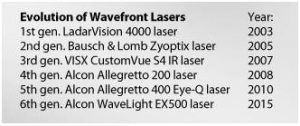There is a wide variety LASIK or laser eye procedures being promoted online, in newspapers, etc. In past few decades many people have overcome their fear of undergoing a laser eye surgery as they have come across so many people who have undergone it- within family, friends, office colleagues etc. Therefore it is no wonder that they are also confused about the different names they encounter plus the different costs.
With so many centres and doctors doing laser eye surgeries, it is not surprising to find no commonality as people undergo procedures with either different doctors, different centres, or even have undergone different types of Laser eye procedures. There are different types of laser vision correction and hence technologies and terminologies are also different. One hears words like “opti LASIK”, LASIK suite, Z LASIK, C LASIK and God only knows how many more new terminologies will keep seeping in this field!!!
What you need to know is the basic simple fact that laser procedures are divided into 3 categories:
- Surface treatments. This works by removing the thin skin of the cornea (part of the eye which needs to be reshaped in any laser eye surgery). This thin transparent skin is called epithelium. The epithelium can be removed using a basic process (PRK), using alcohol (not recommended by us)- LASEK, using a epikeratome (EpiLASIK) or using a surface laser treatment which even “zaps” the epithelium (Trans Epithelial Surface Ablation). What from this is offered to you depends on what the centre has invested in, and also what the treating surgeon is more comfortable doing (his expertise). The reason why surface treatments may be recommended also stem from your eye examination, such as cases with thin corneas, those wanting to join Army, Navy etc meaning careers where LASIK is disallowed. Or patients who have already had previous eye surgery, so a surface treatment is safer for them. Also, those who do not wish a “cut” or corneal flap on their eye (those who have understood the technique and technicalities of the procedure). Disadvantages of this procedure is a much longer recovery, bounce back time on your feet to go back to your job is much longer, need to use steroid eye drops for over weeks, chances of surface irregularities during healing, and hence this is not the first line of laser eye procedures to be recommended.
- The word itself whether it is joined with some other fancy word (Opti, custom, wavefront, T, C, Z etc as the laser company or laser surgeon may desire to rename) means that there is a corneal cut or “flap” made. To reduce the disadvantages of surface treatments- LASIK was born. Does not replace surface treatments in totality, due to the rare indications for some cases, but in general is much more popular due to reduced discomfort, bounce back time shorter, safer, predictable etc. Obviously, there will be many laser systems to do this, by which I mean brands. The laser system used is an excimer system. These have only been advancing with decades to include different softwares, safety features, and increasing advantages for patients. Which to go for? Is again a personal question, depending on how deep you want to get into the technicalities of different laser performances? You may visit the US FDA website if you really want to rack your brains! Or just trust your surgeon!!
An example of evolution in laser systems is as follows:

Now even in LASIK you come across- LASIK using a blade (microkeratome), or the flap can be made using a laser (a femtosecond laser), which is called bladeless LASIK. Mind you, this only differentiates the first step which is creating the flap- use a microkeratome or laser. So, your costs again depend on what type of method is used for flap, and which laser system used to make the flap!
- ReLEX SMILE– the new way of removing powers, without creating a Flap. Due to the disadvantages one reads about the flap- such as fear of the “cut”, corneal healing being affected, dry eyes being induced, flap related surgeical complications etc, one wants to now look at a laser procedure which has the advantages of LASIK but removes its disadvantages, and that is ReLEX smile. This laser is a Femtosecond laser used for the entire procedure. No flap is made, but the initial corneal layer is bypassed by a certain frequency and the power removed in the form of a lenticule. This is best understood by a diagrammatic or video method. Please visit smilerelex.com for the same. Again, ReLEx smile has not replaced LASIK in totality, only cases which ideally benefit from smile should be suggested this procedure. Although results are the same in terms of 20/20 vision or 6/6 achievements, there is reduction in dry eye cases, and no fear of flap related complications which may be a risk for some careers such as in Army, Navy, extreme sports etc where there is risk of flap dislocation.
Hence, from the above variety, you would know that different laser names, different lasers, different surgeon’s experiences all result in the variety of costs.
Our suggestion:
What you should do is compare apples to apples- example a certain laser system to the same one in another centre, then compare experiences, and types of surgeries they offer. Fewer varieties mean lesser options that you would be screened for.
After this, narrow down the list of centres and make your calls to them, send emails. Check if anyone you know has undergone a procedure with them. Ask for testimonials. Assess them also on their response and if the queries you have asked are answered to your satisfaction. Then make a visit to the centre and doctor, and see how that goes. If still dissatisfied or confused take a second opinion. Yes, this may add to the initial checkup cost, but better to be safe than sorry!


 WhatsApp us
WhatsApp us